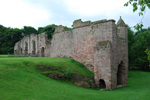History
Constructed of timber, York Castle was built in 1068 by William the Conqueror to control northern England. It was located in York in North Yorkshire, England, near the Old Baile castle across the River Ouse. However, both were burnt to the ground in 1069 by the Danish and English Northerners who opposed William's rule. Only the earthworks of the second castle, Old Baile, remain today.

William paid the Danes to leave England and wanted to face the Northern English in battle, but none would face him. As a result, he burnt cities, towns, and fields to the ground across the north, particularly in Yorkshire and the City of York, as a warning concerning any potential future rebellions. This became known as the Harrying of the North. In 1069 and 1070, York Castle was rebuilt in timber and enhanced to include water defenses, including a moat.
King Henry II temporarily visited York Castle on several occasions and, in 1175, received recognition from King William of Scotland in York. In March 1190, 150 Jews sought refuge within the keep of York Castle from a rioting mob. Surrounded and trapped within the castle, the Jews took their own lives rather than surrender to the rioters. The timber keep was once again burnt to the ground.
Approximately half a century later, in 1244, King Henry III arranged for the rebuilding of York Castle by Master Henry the Mason. The structure was composed of stone to bring it up to the standards of the time. Efforts included the construction of the unique quatrefoil-shaped keep that remains today. Moreover, stone walls replaced timber surrounding the outer bailey, similar to many Norman motte and bailey castles of the period.
King Edward I spent a great deal of time at York Castle, which served as his staging point for aggressions with Scotland in the north. Between 1298 and 1338, royal administrative duties were frequently relocated from London to York Castle. In 1308, 25 Knights Templar were held prisoner at York Castle while awaiting trial at nearby York Minster regarding charges of heresy. In 1310, they were found innocent; however, the order was stripped of its possessions and disbanded. This represented a much less violent outcome than those burned at the stake in France.
By the end of the 14th century, York Castle was primarily utilized as a prison, holding up to 310 prisoners in its towers at any time. In 1536, Robert Aske was imprisoned at York Castle and executed there on the order of King Henry VIII following Aske's protests against the Dissolution of the Monasteries, known as the Pilgrimage of Grace. Towards the end of the 16th century, the Clifford family comprising the Earls of Cumberland became constables of the castle. At this time, the keep became known as Clifford's Tower.
In July 1644, the city of York, including York Castle, surrendered to Parliamentarian forces after Royalists were defeated the day before at the Battle of Marston Moor, just five miles from York. This would be the last conflict involving the castle. Approximately a century later, in 1739, John Palmer was arrested for horse theft and held prisoner at York Castle. Following a letter he wrote to his brother-in-law, a former school teacher recognized the handwriting and identified him as none other than the infamous highwayman Dick Turpin. After that, Turpin was found guilty and sentenced to death by hanging.
By the 19th century, Clifford's Tower was all that remained of York Castle as the mills and prisons were no longer needed. The prison portion of the outer bailey closed in 1929, and several prison buildings were demolished in 1935, except those designated to incarcerate women and debtors.
Castle Highlights
Today, only a tiny section of a rampart wall, a corner tower, and fragments of the south gatehouse behind the Crown Court building, along with Clifford's Tower high atop its earthen motte, remain from the original medieval York Castle. Currently, the structure resides under the care of English Heritage, which manages more than 400 historic monuments, buildings, and places.
The most significant feature of York Castle is undoubtedly the keep referenced as Clifford's Tower. In fact, most people in the north call the castle Clifford's Tower these days rather than York Castle. The keep is unique given the quatrefoil-shaped shell consisting of four overlapping circles similar to the shape of a four-leaf clover. A small forebuilding (gatehouse) at the keep's entrance houses a chapel above the gatehouse.
The castle underwent a major conservation project in recent years, transforming the interior, making more areas viewable to visitors that have been inaccessible for hundreds of years, including the chapel and a medieval garderobe. The keep now has a roof deck where you can attain breathtaking views of York from the top of its remnants or the York Minster across town.
The buildings across the bailey in front of the keep entrance were once used as prisons within the old castle walls but today serve as the Crown Court building and Castle Museum. Behind the Court House are a small section of the outer bailey wall and a small corner tower that avoided destruction when the remainder of the outer bailey was removed during the early 20th century. York Castle can be thoroughly explored in approximately an hour or two. For convenience, a car park is located next to the castle. York Castle is also a manageable walk from York train station.
The city of York surrounding the castle is well worth a visit. Highlights include cobblestone streets, Viking and Roman history, and the York Minster. For spine-chilling fun, I recommend the Ghost Hunt of York which begins at Shambles every night at 7:30 PM.
The castles of Knaresborough, Spofforth, and Ripley are located within 50 miles of York to the east towards Harrogate.
Read the story of the bleeding walls of Clifford's Tower.




